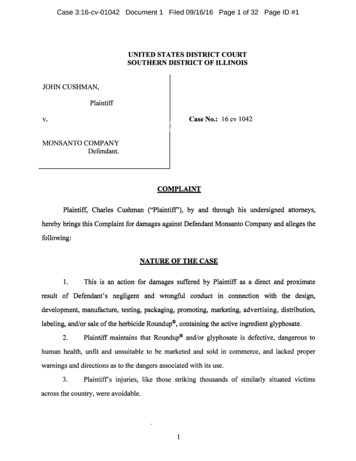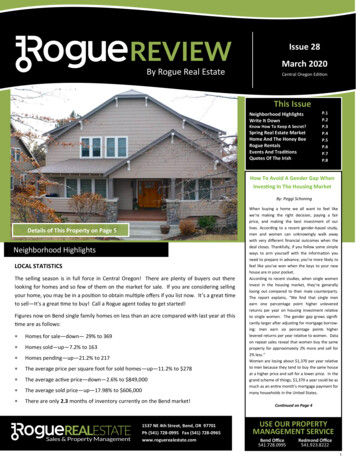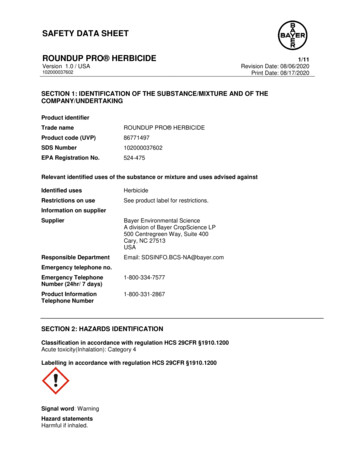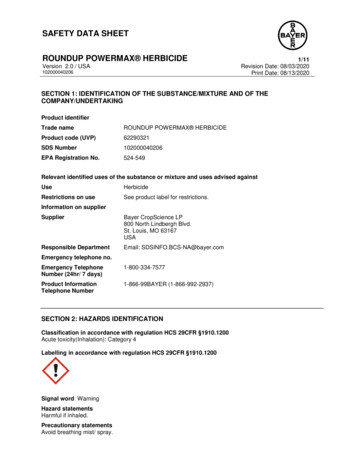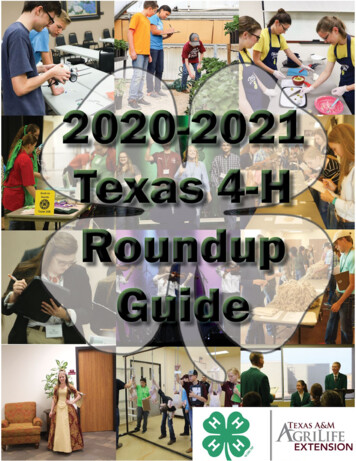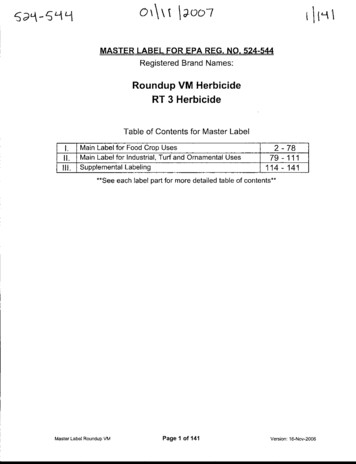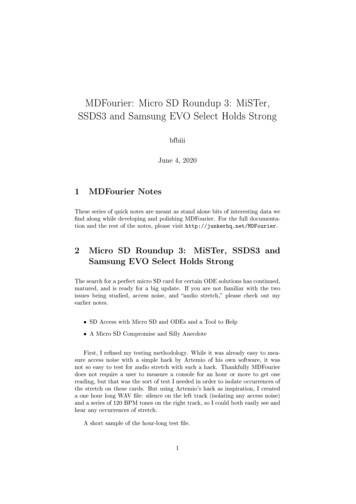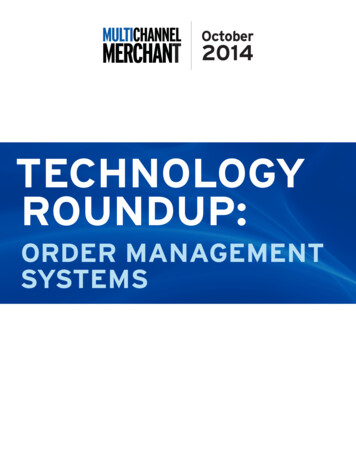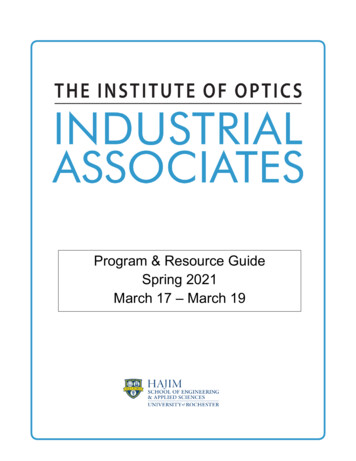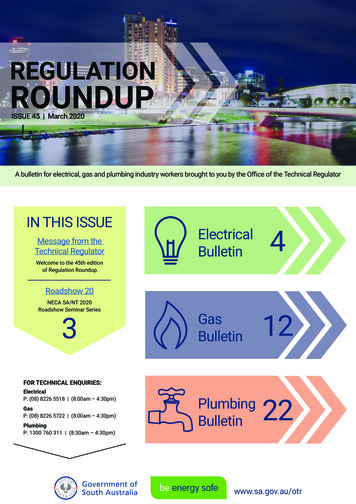
Transcription
REGULATIONROUNDUPISSUE 45 March 2020A bulletin for electrical, gas and plumbing industry workers brought to you by the Office of the Technical RegulatorIN THIS ISSUEMessage from theTechnical RegulatorWelcome to the 45th editionof Regulation Roundup.ElectricalBulletin4Roadshow 20NECA SA/NT 2020Roadshow Seminar Series3GasBulletin12PlumbingBulletin22FOR TECHNICAL ENQUIRIES:ElectricalP: (08) 8226 5518 (8:00am – 4:30pm)GasP: (08) 8226 5722 (8:00am – 4:30pm)PlumbingP: 1300 760 311 (8:30am – 4:30pm)be energy safewww.sa.gov.au/otr
Messagefrom theTechnicalRegulatorWelcome to issue 45of Regulation Roundup.Welcome to issue 45 ofRegulation Roundup. Weare again approaching theroadshow seminar series.I would encourage all of you totry to get along to one of thesesessions while we tryto cover all the topical issuesin Regulation Roundup.In this issueMessage from theTechnical Regulator Electrical Bulletin 24Existing non-compliantelectrical work 4Segregation of different voltage levels 7RCD protection of all final sub circuits 7Read the instructions! 8Backup circuit arrangement 8Earth Electrode Clearances 8Electric Shock Report Incidents 9OTR Electrical Expiations 10AS/NZS3000:2018 Wiring Rules –Amendment 1 Public Warning Notice 1011It’s always great to be able to catch upin person to ask any questions you mayhave. In this edition of RR, I note we areexploring several issues we are findingwith the installation of battery storagesystems. Please take note of these ifyou are in this part of the industry. Thelatest update in Standards impactingon this sector will also be covered off atthe roadshow. We also devote a sectiondiscussing in detail the installationand commissioning of gas appliances.Gas Bulletin Material Failures 2020 Gas Roadshow Commissioning Type A GasAppliances, Hang and Wad MeterFixes and Spillage Testing The pressure’s on! Commissioning LPG appliances Installing gas appliances Are you working on un-certifiedappliances? Complex gas installation LPG installations Product Safety Recall Audit feedback 121213141515161718192021This is a must read for those in the gasinstallation industry. It can help youavoid any problems that would requirerectification. In the water industry wehighlight a number of issues wherewe have published advisory notes forthe industry. Once again, I encourageyou to take the time to have a read ofRegulation Roundup and trust it is ofuse to you.Robert Faunt, Technical RegulatorCentral heater installations inroof spaces Plumbing Roadshows 2020 212222Plumbing Advisory Note Tundish connections 23Plumbing Advisory Note - Advice toProperty Owner 25Plumbing Bulletin Publication of Standard for DualReticulation Infrastructure Infrastructure Standard Wayne Bennetts Retires Contact list 26272728
CALLING ALL ELECTRICIANSROADSHOWSEMINAR SERIES ANNIVERSARYNECA SA/NT will be running their 2020 Roadshow Seminar Series across SouthAustralia in March, April and May and we encourage all electrical contractors andworkers to attend and find out the latest developments within the industry. The seminarswill cover updates to Australian Standards, Solar and Battery Storage, theService and Installation Rules, NECA’s new HSEQ Digital product and much more.This year NECA are celebrating running the Annual Roadshow Seminar Series for 20 years!This means the seminars will be even bigger and better than before, with extra prizes,giveaways and more. It will be an event not to be missed!This annual seminar series is a significant trainingresource for the electrotechnology industry. The eventthis year is designed to provide licensed electricianswith a greater understanding of the following topics: NECA SA/NT on our new HSEQ Digital product MATES in Construction on Tradies Mental Health SA Power Networks on changes to the Service andInstallation Rules Office of the Technical Regulator on updates to theAustralian Standards including ‘Battery Storage’,‘Transportable Structures’ and ‘Construction andDemolition Sites’, the new DER Registerrequirements for Solar installers, and other updatesand FAQ’s.Thanks to the Office of the Technical Regulator,SA Power Networks and MATES in Constructionfor their support and involvement in this initiative.NECA have nominated Mates in Construction tobe our charity of choice for the 2020 RoadshowSeminar Series.There will be donation tins available at eachseminar, and more information will be provided onMIC, the fantastic work they are doing for theconstruction industry and why they need our help.Suppliers, manufacturers and wholesalers will beon location with their new products and servicedisplays and NECA SA/NT staff will also be onhand to answer your questions about whatNECA can do for you and your business.Don’t miss out on our 20th Anniversary year!To attend for the NECA 2020 Roadshow Seminar Series, please register via Eventbrite f RegRoundupREGISTERAlternatively, you can visit our website and download the hard copy registration seminar-series.For further information or assistance please phoneNECA SA/NT on (08) 8272 2966 or visit www.neca.asn.au/saSA / NT CHAPTERREGULATION ROUNDUP 3
ElectricalBulletinExisting non-compliant electrical workSeveral electricians have raised concerns about what to do if they find existing non-compliantelectrical work.As with the previous paper certificates, the new electronic certificates of compliance (eCoCs) haveSection B, which is used to warn the property owner of any existing electrical non-compliance thatan electrician identifies.Electricians are not responsible for electrical work previously done by others however they havea duty of care to warn the property owner/occupier of any non-compliance that they happen toidentify. Under Section 60 of the Electricity Act, owners & operators of electrical installations musttake reasonable steps to ensure that their electrical installation is safe, and safely operated.If you come across non-compliant electrical work, ask the owner if they want you to rectify it. Ifthey agree, rectify the work and list it in Section A on your eCoC as work you have carried out. Donot then also list it on the eCoC as a defect in Section B, as you have already fixed it. If they sayno, then write what you have found in Section B on your eCoC. Section B gives 5 categories for theelectrical installation. Refer to the examples shown below. Any option other than None Observedrequires the electrician to describe the non-compliant work.Immediately dangerous[ Exposed live conductors. ]NOTE: If you select immediately dangerous, you will then be given ascreen prompt requiring you to ring OTR immediately. OTR will thenstep you through what is required to make it safe.[ Exposed live terminals. ]REGULATION ROUNDUP 4
[ Existing non-compliant electrical work . ]Potentially dangerous[ Earth bar used as active link, in breach of clause 1.7.1(c) AS/NZS 3000:2018. ][ Main switchboard enclosure is not earthed, in breach of clause 5.4 ofAS/NZS 3000:2018. ]Non-compliant[ Connection to earth electrode is not protected against corrosion and has nowarning label in breach of clauses 5.5.1.2 and 5.5.1.3 of AS/NZS 3000:2018. ][ Meter isolator is not also labeled ‘MAIN SWITCH’, in breach of clause 7.5 ofthe SA Power Networks Service and Installation Rules. ]REGULATION ROUNDUP 5
[ Existing electrical installations . ]RecommendRecommendations are not for identified non-compliance.They are for where you believe that the electricalinstallation could be: made safer, such asupgrading an existingold switchboard Replace existing old‘Cap and Casing’ wiringsystem in house.or neater, where it isobvious that theprevious electrician didnot own a spirit level.None observedWriting “none observed” on your eCoC does not make youresponsible for the existing electrical installation. All it is sayingis that, whilst carrying out the electrical work listed in Section Aon your eCoC, you did not identify any non-compliance.REGULATION ROUNDUP 6
Segregation of different voltage levelsWhere a solar and/or batterysystem has an extra-low voltageinterconnection cable installedin association with low voltagewiring, appropriate segregationmust be maintained.AS/NZS 3000 clause 3.9.8.3states that:Cables of low voltage circuits and cables of extra-low voltage circuits shall onlybe enclosed in the same wiring system where one of the following arrangementsis employed:a. The low voltage cables are of a type providing the equivalent of double insulation.b. All cables or each conductor of a multi-core cable are insulated for the highestvoltage present.c. The low voltage cables are installed in a separate compartment of a common cabletrunking system, having fixed and continuous barriers between compartments.[ This extra-low voltage cable is only rated for 30 V and does not have sufficient segregation fromsingle insulated low voltage cables. ][ Excess sheath has been stripped back on extra-low voltage cable, andhas impaired its insulated voltage rating. ]RCD protection ofall final sub circuitsOTR are finding many separate “control circuits”in residential installations that are not being RCDprotected. These circuits are final sub circuitsand shall be protected as such. AS/NZS 3000clause 2.6.3.2.2 states that: Additional protectionby RCDs with a maximum rated residual current of30 mA shall be provided for all final sub circuits indomestic and residential electrical installations.[ Metering device final sub circuit is not RCD protected. ]REGULATION ROUNDUP 7
Read the instructions!When RCDs are installed to protect electricalinstallation connected loads on a stand-alone portof a multiple mode inverter, they shall be of a typethat correctly operates on the standalone port outputwaveform and be in accordance with the requirementsspecified by the manufacturer for use with the inverter.Type ACType A[ Here is an example of 2 RCD’s of the same make, howeverthey are different types. One is a type AC RCD and one is atype A RCD. The manufacturer of the multi mode invertermay specify only one type of RCD to be used. ]Backup circuit arrangementIt’s important to arrange your backup circuits in a mannerthat is easy to understand. Anyone should be able to opena switchboard and isolate everything safely without it beingtoo confusing. AS/NZS 4777.1 clause 5.4.3 states: a multiplemode IES with stand-alone functionality, the final sub-circuitsof the multiple mode inverter should be located in a separateEarthElectrodeClearancesstand-alone supply load centre or distribution switchboard. Where thestand-alone supply is used as an alternative supply for the electricalinstallation, the alternative supply arrangements of AS/NZS 3000shall be applied. All sources of supply associated with multiple modeIES shall be clearly identified and uniquely labelled.AS/NZS 3000:2018 Clause 5.3.6.4 (b) statesthat earth electrodes must maintain separationfrom conductive enclosures of other buriedservices. The Clause also gives reference totable 3.7, which gives minimum separationof underground services. In most cases youwill find the minimum separation is at least500mm to other conductive services suchas water and gas.[ Earth electrode too close to a gas service. ]During our investigations, electricians aretelling us they installed the electrode at thebeginning of the construction prior to the gasand water pipes, so did not cause the breach.While this may be true, the breach still existson the property. Our advice is to be aware andinstall the electrode well clear of where otherservices are required to be installed later, asthe builder will need to choose which tradieneeds to relocate their service, they usuallycall the sparky.[ Earth electrode too close to a water service. ]REGULATION ROUNDUP 8
[ Electric Shock Report Incidents ]Shock SourceCauseContributing FactorsInjuriesAction to Make SafeCable installedin roof space.Cable was notterminated andwas believed to beredundant.Apprentice plumber brushed hand pastthis cable whilst working in roof space.Electric shockreceived to right hand.Electrical contractor isolatedarea and terminated cables asrequired.Christmas Treedecoration.Flexible cord haddamaged insulation.Worker went to check why Christmaslights did not work and whenunplugging them contacted liveexposed conductors.Electric shock to lefthand.Item removed and dangertagged out of service.Worksite procedures reviewed.Terminals ofair-conditioner.Isolators notadequately labelled.Refrigeration workers hand brushedagainst terminals of air conditionerthat was supposedly isolated.Worker receivedelectric shock tohand.Review of isolating proceduresrequired, and correct labellinginstalled.Kitchen taps.Neutral conductorpulled out of “over tounder” service fuseconnection.Homeowner using kitchen tapsreceived electric shock unaware thatfencing contractor had damagedconsumers mains neutral conductor.Homeowner receivedelectric shock tohand.Network operator isolatedsupply until electricalcontractor completed repairs.Undergroundstreet mainscable.Star dropper hadbeen driven intounderground streetmains cable.Building site worker contacted thenow live star dropper unaware it haddamaged the street mains.Electric shockbetween handand foot.Network Operator isolatedstreet mains to effect repairs.Builder to reviewsite procedures.Lighting cable.New checker plateflooring had beeninstalled.Workers had inadvertently cut throughconduit and cable when renewingwalkway.Worker receivedelectric shock toright hand.Circuit isolated and conductorrepaired. Site proceduresto be reviewed to eliminatereoccurrence.Bread toaster.Toast was stuckand could not bedislodged.Hospitality assistant decide to usemetal food tongs to remove toastwhilst toaster still energised.Worker receivedelectric shockbetween left handand right foot.Safe work proceduresreviewed with worker. Toasterremoved form service andreplac
REGULATION ROUNDUP 3 SEMINAR SERIES ANNIVERSARY ROAD SHOW NECA SA/NT will be running their 2020 Roadshow Seminar Series across South Australia in March, April and May and we encourage all electrical contractors and workers to attend and find out the latest developments within the industry. The seminars will cover updates to Australian Standards, Solar and Battery Storage, the
